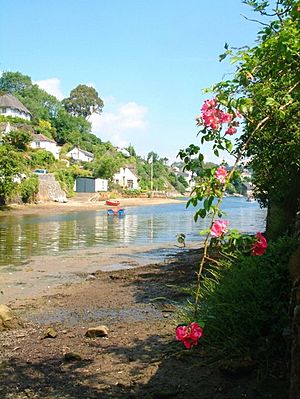Helford River facts for kids
The Helford River (called Dowr Mahonyer in Cornish) is a special kind of river valley in Cornwall, England. It's actually a "ria," which means it's a river valley that has been flooded by the sea. Many small streams flow into the Helford, creating several beautiful creeks.
There are seven main creeks on the Helford River. From west to east, these are Ponsontuel Creek, Mawgan Creek, Polpenwith Creek, Polwheveral Creek, Frenchman's Creek, Port Navas Creek, and Gillan Creek. The most famous one is Frenchman's Creek, which became well-known because of a novel by Daphne du Maurier with the same name. A little further up the river, you'll find Tremayne Quay. This quay was built in the 1840s for a visit by Queen Victoria, but she never came, supposedly because it was raining!
Contents
What's in a Name?
The name "Helford" has an interesting history. An old historian named William Hals (who lived a long time ago, dying in 1737) wrote about the river. He called it "Hayleford channel." In the Cornish language, "Hayle" means "estuary" (where a river meets the sea), and "ford" is an English word for a shallow place where you can cross a river. So, the name basically means "estuary crossing."
River Life: From Work to Fun
For a long time, the Helford River was a busy place for work. It was like a watery highway for local mines, farms, and quarries. People also used it for fishing. Back in 1882, ships called "colliers" (which carried coal) would unload their goods at Merthen Hole. Bishop's Quay was a busy spot for a dozen boats that caught pilchards (a type of fish).
Today's Activities
Most of that old industry is gone now. However, some commercial fishermen still use the river to bring in their catch. This fishing brings in about one million pounds sterling each year! The oyster fishery is also starting to grow again.
Instead of heavy industries, the river is now a popular place for tourists. Many people visit for sea-related activities. At the very top of the river, you'll find the Gweek Boatyard, which is a large business. There's also the Cornish Seal Sanctuary nearby. This amazing place helps injured seals get better before they are released back into the wild Atlantic Ocean. So, the river has changed from a place of heavy work to a place for lighter businesses and tourism.
Protecting the Helford
The Helford River area is very special, so it has several important protections. It's part of a Special Area of Conservation (called Fal and Helford) and a Site of Special Scientific Interest (Lower Fal & Helford Intertidal). It's also part of the Cornwall Area of Outstanding Natural Beauty, which means its natural beauty is protected.
Many groups work together to keep the Helford healthy. The National Trust helps with their plans for the area. Natural England also helps by protecting and watching over the environment. What's unique about the Helford is that no single authority manages it. Instead, many environmental groups and organizations work together to protect and develop the river. They suggest important rules, like those from the Helford River Marine Conservation Group, to keep the river safe and beautiful.
Villages, Ferries, and Harbours
Several charming villages are located along the Helford River. These include Gweek, Port Navas, Helford village, Helford Passage, and Durgan.
Exploring the Villages
- Gweek is the largest of these villages. It has more people living there all the time, along with businesses, shops, and a pub called The Gweek Inn.
- Helford village is on the south side of the river. It has a shop, a post office, the Helford River Sailing Club, and a pub called The Shipwrights.
- Helford Passage is on the north side of the river and has a pub called The Ferryboat.
The Helford Ferry
Helford village and Helford Passage are connected by a special passenger ferry. This ferry has been running for more than 300 years! It carries people and bicycles across the river.
Port Navas is home to the Duchy Oyster Farm, where oysters are grown. The most important spot in Port Navas is its quay, which is a historic structure. This quay is owned by the Duchy of Cornwall. Over time, the quay has become damaged. Because of this, a group called "Preserve Port Navas Quay" has been formed. Their goal is to protect and fix the quay and to help the environment in the Helford River area.
In the past, the woods around the Helford River were also used for industry. After a local landowner, Sir Richard Vyvyan, passed away in 1879, his family continued to use the wood from their estate. Old oak and fir trees were cut down and sent from Bishop's Quay to coal mines in south Wales and other towns in Cornwall.



